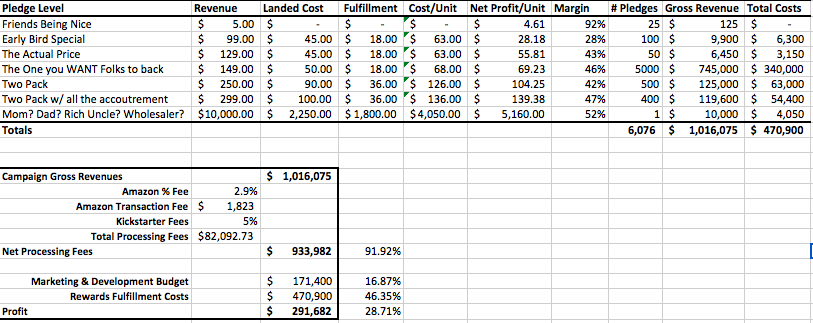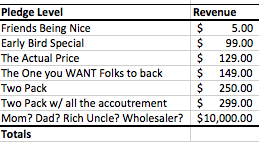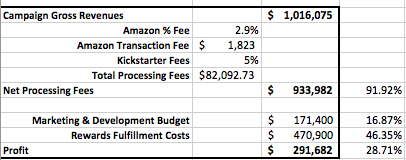How To Financially Build A $1 Million CrowdFunding Campaign
If you want to turn a prototype or small project into a marketable product than profitability is a major concern. These days any hardware or new device, whether it is a small DIY project or a large enterprise development, will encounter the question “Why not do a kickstarter?”.
There are many reasons both for and against crowdfunding campaigns, but that is not the basis for this article. Instead this reviews a basic financial analysis of what goes into a crowd-funding campaign. The assumption is that you have a device, product, or project that you are ready to move forward with, but you need to work out the details of the campaign itself.
The below model is based off of multiple contacts experience with campaigns and has been modified from a Kickstarter project that raised over $150,000. It has also been used to STOP a project from moving forward as one client realized the time and effort would be better spent looking for a manufacturing partner who was willing to pay a license royalty.
Keeping in mind that running a crowdfunding campaign is like any other business, it is important to understand all the areas that might make costs creep up. Shipping a commercial product, with the relevant QA, logistics, returns, and customer complaints is very different from making a few extra of something for friends and family. Importantly there are no areas that will cut into your bottom line, so if you expect to run a $1,000,000 campaign and pocket $1,000,000, be prepared for a shock.
The $1Million Campaign Financial Review

Above is a simplified financial model for a $1,000,000 Kickstarter campaign. Your goals may vary but this seems to be a round number that convinces people they will be the next maybe thing. A couple takeaways from these numbers jump out immediately.
Number of Backers (6000+):
That is a lot of potential customers. It’s a lot of emails to keep track of, a lot of boxes to pack and a lot of costs. Depending on your conversion rates, the number of people who back compared to the number of people who see the campaign, this might be 10% or less of the total people you will have to speak to in one way or another.
Average Spend ($167):
This is simply the total amount raised divided by the number of backers. Sure you may be able to bring this number down, but in doing so you will have to reach more people. What was the last thing you spent $167 on? Did you think twice before buying it, and how high were your expectations? That is a substantial amount of money.
Reward Level Range ($5-$10,000):
Each Reward level represents a unique market segment and a full product to manage. Though some levels may be “early-birds” at a lower costs, for the most part the unique levels will each require it’s own messaging, images, packaging, timeline, fulfillment details, testing, and marketing spend. That is a LOT to manage. The number of rewards levels varies widely depending on what the product is but most successful campaigns have things in place to help them get out of the gate quickly and get to 30%-40% funded. That includes large rewards levels for distributors that will knowingly come on board in the first hours, early bird specials at a discount to dri ve scarcity and get backers, as well as a floor on pricing that still creates decent traction. It’s worth noting that you should be able to get some friends to simply throw you $20 regardless of what they get in return, if that is the case consider avoiding the $1 backer level and get them to really support you. For $1 someone is likely to forget about it but for $20 there is a good chance they’ll become an advocate and share with their friends, even if they themselves don’t trade up to higher levels.
ve scarcity and get backers, as well as a floor on pricing that still creates decent traction. It’s worth noting that you should be able to get some friends to simply throw you $20 regardless of what they get in return, if that is the case consider avoiding the $1 backer level and get them to really support you. For $1 someone is likely to forget about it but for $20 there is a good chance they’ll become an advocate and share with their friends, even if they themselves don’t trade up to higher levels.
Fees & The Platform Cut ($90,000):
In the case of kickstarter there is around 8% of the funds that will go to Kickstarter fees of for payment processing. This is not unlike a retail store, that shares 3% for the privilege of billing directly to your Visa card. It is the cost of doing business and for anyone unfamiliar with running their own business may be a shock. Your goal should, realistically, be to make this number so big it makes you sick.
Fulfilment ($18/per):
Do any amount of googling about failed projects and you will find stories of fulfilment costs derailing efforts. We have all become so accustomed to “Free Shipping” that it is easy to forget how much goes into bringing a box from one place to another. Even if you are sending digital goods this is unlikely to be $0 and for hardware the fact that you are likely low volume will ensure this number is higher. Plan ahead for how big the box is, and who will do the delivery. One of the best “hacks” I have heard of is a campaign that designed their entire package to slide into the sleeve of a $5.40 USPS box that was (at one point) free from the post office. This is also one place where you can consider the volume and determine if it is best to do it yourself. If it saves $1, then manually loading 6000 and sticking a label on it may save you $6000 and make it worth it to do this yourself instead of involving a third party fulfilment service. If this is your plan though, you should consider what happens if you have a very successful campaign. Trying to go to a more costly, but reliable, fulfilment system after the fact is what will make your profits disappear.
Marketing ($150k +):
The most successful companies in the world know that they will spend money on marketing. If you want to get a sense of how much, check the financial filings of publicly traded companies and they range widely but for most consumer products it’s rare to see anything under 10%. For a $1M campaign that means you will likely spend $100,000 on marketing. This can be across media (facebook & display ads), PR (for an agency), flyers, email campaigns, billboards, trade shows, you name it. If you have never managed a $100k+ marketing budget before consider finding a contact who has and get their take. An agency will be happy to take this money off your hands, but if all they are doing is taking a 20% management fee and then buying adwords you may be better off doing this yourself. Even so consider that a professional in the space may be able to make this money work much harder for you. Your budget may be tracked directly to how many backers you get, but done correctly this will be the start of much more to come and it is important to set the groundwork to avoid wasting money redoing everything again.
Profit ($240k):
This may seem like a lot of money, but it is not really “profit” just yet. As the spreadsheet is built this is more like your operating margin. That means that all of your overhead must be covered by this number. If you are a single person running a campaign and doing everything yourself that may make sense, but chop this up between 2-3 people and consider the cost of your time and suddenly it is not that much. Also, if this is the start of a true business everything from corporate filings, product liability insurance, accounting, etc. will eat away at this numbers. It is of course possible to do this all yourself but the balance of where it makes sense to pay a professional, versus how much headache and time you want to spend on something, is always present. If you are the inventor/designer/produced/manufacturing of your product, any time spent trying to eek out a few extra dollars in this category may come at the cost of making your next campaign a success.

